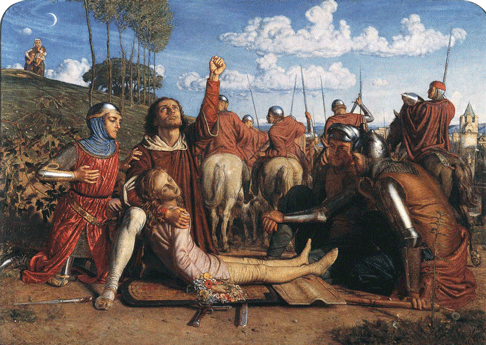The orchestra sounds good, lovely
rich string sounds that prefigure Tannh‰user, and coarse versions of
Wagner’s endless modulation, continually reworking musical material to
disguise his slight melodic gift. But it went on and on, brass choirs and
brainless choruses, lovers rejoicing or denouncing, nobles sulking and
plotting, and it was difficult to be sure which singer was playing which role;
no synopsis was provided and, in Wagner’s libretto from a Bulwer Lytton
novel about fourteenth-century Roman politics, only the three leads have any
individuality.
Rienzi rates a single paragraph in Ernest Newman’s Wagner
as Man and Artist. Newman loved Wagner, and his books are the best
front-line tomes for background and analysis. He approved Wagner’s
distinction between the “romantic operas” (up through
Lohengrin) and the “music-dramas,” and when he said Wagner
was the greatest opera composer who ever lived, he meant
aside from the total-art-works in their higher realm. Yet even Newman
(who has a ten-page warm spot for Das Liebesverbot) couldn’t
come up with a kind word for Rienzi. “Almost offensive”
and “a sheer failure of the imagination” are his dicta on the
opera’s musical language. “It is astounding how few phrases there
are in all these six hundred pages.” He grudgingly admits the
“rampant horse-power vigor” of the overture (the only bit of the
work we generally hear), then returns to its “vulgarity, its intolerable
prolixity.”
I can’t disagree with this assessment, though Rienzi does
offer the intriguing spectacle of youthful genius finding himself…and
not quite getting there yet, just as Mozart does with Mitridate or
La finta giardiniera. And, to be fair, Rienzi achieved just
what its composer desired: A hit at its premiere, it remained popular for
years, whereas Fliegende Hollander and Tristan took decades
to enter the general repertory. From the chatter around me, I gathered that the
house was full of last-minute attendees, lured by a spate of ten-dollar
tickets, and that these newbies were happy with what they encountered, with the
performance’s sheer busyness. Can opera lovers be so shallow
that huge performing forces in colorful costumes and martial formation making a
huge noise in a huge room, the power of mere spectacle, overwhelms refinement
of taste? Well, you know the answer to that one.
 Rienzi Vowing to Obtain Justice for the Death of his Young Brother by William Holman Hunt
Rienzi Vowing to Obtain Justice for the Death of his Young Brother by William Holman Hunt
The Met last gave Rienzi in 1890; 122 years do not justify any call
for its revival. Opera Orchestra of New York has given it in concert four times
now, at least two more than curiosity could merit, but Eve Queler loves operas
that have lots of moving parts, brasses scattered around the room, choral
groups marching up and down the aisles, a long organ solo, and Rienzi
gives her all that. Wagnerians used to sneer at Rienzi as “the
greatest Meyerbeer opera,” but that is because they do not know
Meyerbeer’s tuneful, elegant, dramatically pointed scores. The only thing
Meyerbeerian about Rienzi is its grotesque length. (Queler cut it
significantly, of course: An uncut Rienzi could last five hours easy.)
Rienzi’s repetitiveness, the thrill in exploiting its slight
substance, no one would deplore more than Meyerbeer, unless it be the mature
Richard Wagner. Effects without causes—that’s what we have here.
The 27-year-old composer, weary of being an underpaid, over-indebted opera
conductor and critic, wanted to demonstrate he was ready for hardball with the
big boys. You know: Spontini, Auber, HalÈvy… Too, he wanted to write an
opera on imperial themes to set pre-unified Germany afire, and he wanted to set
it in Italy because … well, because. But he hadn’t yet visited
Italy. So the local color of his medieval Rome is very beer hall. A loud beer
hall. A loud, smoky, Germanic beer hall. Hitler is said to have adored
Rienzi, but too much need not be made of that: He also adored Die
Meistersinger and The Merry Widow.
So the orchestra was okay on this occasion, and the choruses rather good,
but what of the singers? Ian Storey, a well-known mediocre Tristan, was in
appalling shape, not an unforced tone all day. As no announcement of ill health
was made, one must assume he just wasn’t up to the stentorian title role,
though he sounded very sick and Queler may simply not have had a
replacement handy. (Who learns this role any more? Why bother?) Geraldine
Chauvet in the musico (i.e., trouser) role of Adriano
Colonna—the only character in the opera with a dash of
personality—had a far happier day and the applause to go with it. She
sang the Prayer that is the only vocal number ever excerpted from
Rienzi, and though not entirely in charge of it, produced fine phrases
in a yearning style and got through her Wagner turns, the composer’s
favorite ornamental figure, with credit. Elisabete Matos, who made a thrilling
Met debut last year in Fanciulla del West but is better known in
Europe for dramatic roles, sang Rienzi’s sister and Adriano’s
girlfriend, Irene, a one-(very high)-note idealistic personality whose soprano
must cut through the orchestra like a gleaming bread knife. Matos had the sheen
and was usually on the right pitches, and her final, suicidally heroic outburst
implied that she’d sing one hell of a Senta if she got the chance. Among
the lesser figures, baritone Shannon DeVine and soprano Emily Duncan-Brown
distinguished themselves.
John Yohalem
image=http://www.operatoday.com/ColaDiRienzo.gif
image_description=Statue of Cola Di Rienzo by Girolamo Masini, erected in 1877 near the Campidoglio
product=yes
product_title=Richard Wagner: Rienzi
product_by=Irene: Elisabete Matos; Adriano: Geraldine Chauvet; Rienzi: Ian Storey; Baroncelli: Jonathan Winell; Cecco del Vecchio: Shannon DeVine; Messenger of Peace: Emily Duncan-Brown. New York Choral Society and Opera Orchestra of New York, conducted by Eve Queler. Avery Fisher Hall. Performance of January 29.
product_id=Above: Statue of Cola Di Rienzo by Girolamo Masini, erected in 1877 near the Campidoglio